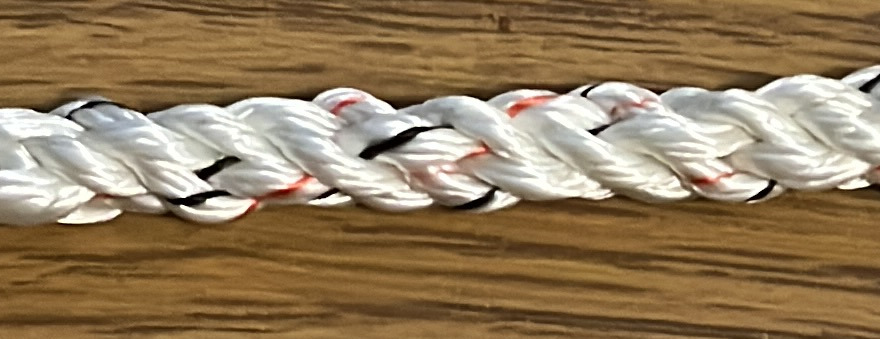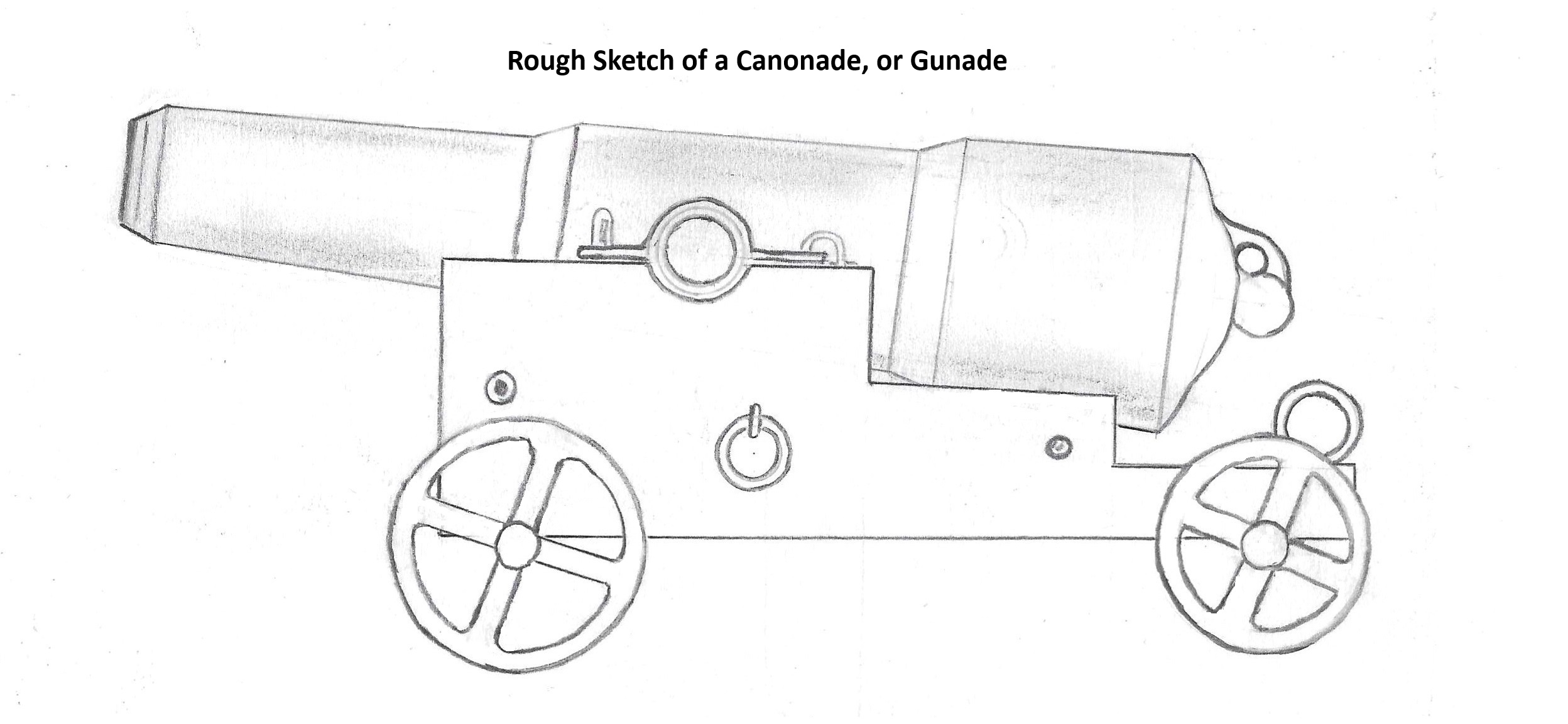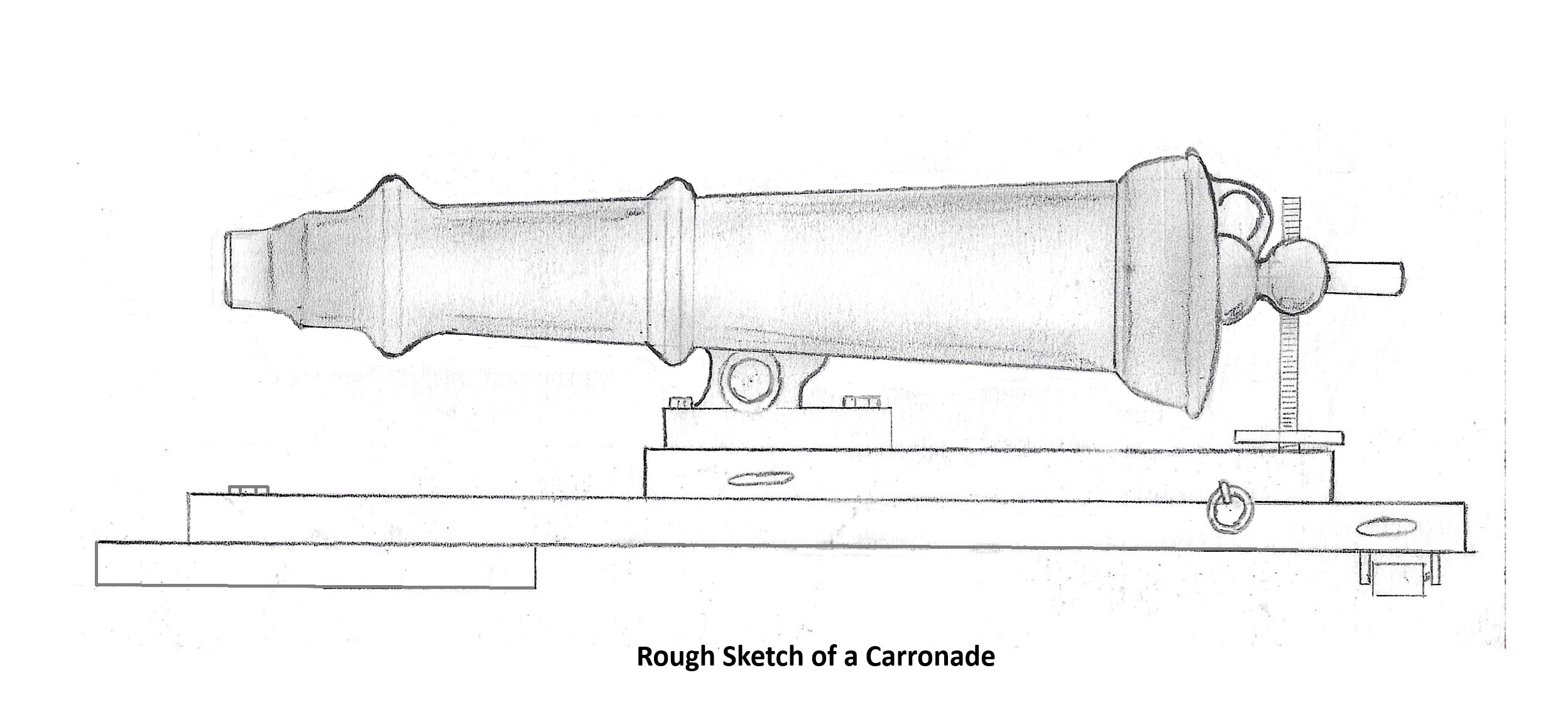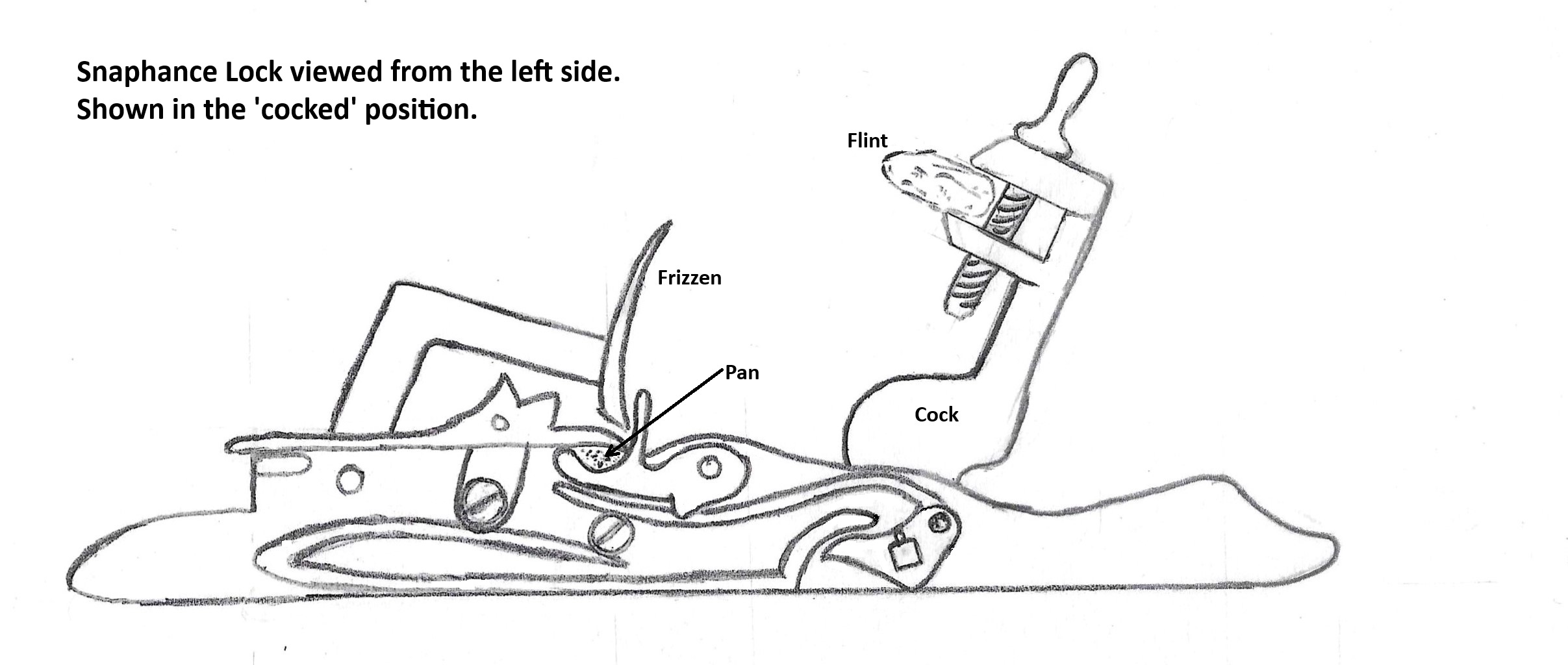Tis page lists items and terms that may be unfamiliar.
| Item | Description |
| &c | Etcetera |
| 18 Pounder | An intermediary calibre piece of naval artillery mounted on warships of the Age of Sail. They were used as main guns on the most typical frigates of the early 19th century, on the second deck of third-rate ships of the line, and even on the third deck of late first-rate ships of the line. |
| Acct | Account |
| Aprons of lead | Sheets of lead with “fingers” were used to cover the touch hole of a gun, protecting the powder and the fuse from water spraying into the gun ports. Lead is malleable and could be formed to the shape of the gun barrel, while the fingers could be bent to create a tight fit around the breech of the gun. A hole on either edge of the apron would fit a lash to keep the apron tied in place. Many of the gun aprons from Queen Anne’s Revenge (Blackbeard’s flagship) also have a variety of marks carved into them, the most obvious are “wigglework” M’s or W’s and etched arrows. These marks appear similar to those carved into timbers in 17th and 18th century English homes, called “apotropaic” symbols, meant to protect the residents from witchcraft. |
| Archd | Archibald |
| Artificer | A skilled craftsman |
| Axletree/axtree | A bar or beam of wood or iron, connecting the opposite wheels of a carriage, on the ends of which the wheels revolve. |
| Barras | A coarse linen fabric originally imported from Holland. The word was in use in the seventeenth century. The word also refers to a Glaswegian market place traditionally a place where fabric was sold. |
| Baulk | A heavy wooden beam, generally a whole log that has been squared off and used to provide heavy support for something such as a roof. |
| Bed | Wooden plate on a gun carriage onto which the coins would be mounted. |
| Bishop Mark | So named after Henry Bishop who, as Britain’s Postmaster General from June 1660 to April 1663, introduced the date stamping of letters upon receipt. The Bishop Mark endured until about 1790 when a more elaborate, sometimes less clear, replacement was introduced. |
| Boatswain | Person responsible for ropes and rigging. |
| Bottom | The lower part of a gun’s carriage. |
| Brackets | The lower sides of a gun carriage. |
| Breast Bolt | Used to secure breast plates on the forward face of a gun carriage. |
| Breechings | A thick rope used to secure the carriage of a cannon on a ship and to absorb the force of the recoil. |
| Budge Barrel | The small barrel of gunpowder which, in the days before powder was made up into cartridges, was brought on deck to serve the guns. It held a hundredweight (about 50 kg) of powder and the top end was fitted with a leather flap or bag drawn tight by a string which, when the barrel was brought to the guns, covered the open end to lessen the danger of accidental firing. |
| Button | A spherical knob, or projection from the breach of a great gun used to secure the breechings. (see ‘anatomy of a great gun’). |
| Cable | 1. Unit of measurement, typically referring to rope. 1 cable = 100 fathoms or 600 feet. 2. A six stranded rope laid in both directions so that stretching is reduced. Thus:  |
| Cablet | 1. Unit of measurement, typically referring to rope. 1 cablet = 720 feet. 2. A cable laid rope of less than 10 inches in circumference. |
| Camphor | A waxy, flammable, transparent solid with a strong aroma. It is a terpenoid with the chemical formula C10H16O. It is found in the wood of the camphor laurel (Cinnamomum camphora), a large evergreen tree found in East Asia; and in the related kapur tree (Dryobalanops sp.), a tall timber tree from South East Asia. It also occurs in some other related trees in the laurel family |
| Capsquare | A metal plate used to retain the trunnions onto a gun carriage. |
| Canonade | A short gun, (sometimes referred to as a Gunade), similar in appearance to a carronade, yet with trunnions thereby allowing them to be mounted in a gun carriage. They could be regarded as a hybrid of a carronade and a long gun. |
| Carronade | A short gun, manufactured by the Carron Iron Works in Falkirk. They were primarily used on the quarter deck where space was at a premium, yet later were more widely used. They were mounted on a slide rather than a carriage, and fired oversized shot; at close range, they were devastating. |
| Cartouche | A paper cartridge containing powder and shot. |
| Cartouche box | A leather pouch worn to hold cartouches. |
| Cascobel | A ring of metal above the button behind the breach of a gun, used to secure the breeching. (See ‘anatomy of a great gun’). |
| Chalk | Chalk was used for a variety of purposes. Gunners used chalk marks to denote the centre line of their artillery for sighting. They also marked the position of their gun on the deck so that they could return it there after firing. Powdered chalk could also be mixed with cooking fat to seal seams in planking. Lots of uses. |
| Chevaux-de-ffreese | Cheval-de-frise. An obstacle made of stakes or spikes attached to a log, wooden frame, or metal drum and used to block enemy advancement or prevent unauthorized access. |
| Cohorn | A lightweight mortar originally designed by Dutch military engineer Menno Van Coehoorn. |
| Coins | Also spelled coyns or quoins. Wedge shaped pieces of wood used to control the elevation of a gun’s barrel. |
| Corn Powder | Coarse gunpowder used as charge for a gun. |
| Cross garnet | A T shaped door hinge. |
| Crows of iron | Crow bars |
| Culverin | A large cannon of 17 to 20 pounds. |
| cwt | Hundredweight |
| Deale | Was an archaic UK and US unit of volume used to measure wood. In the late 18th and early 19th centuries, a deal originally referred to a wooden board between 12 and 14 feet long that was traded as a maritime commodity. |
| Demi-Culvering | Medium cannon similar to but slightly larger than a saker and smaller than a regular culverin developed in the late 16th century. |
| Demorage | Detention of a ship, freight car, or other cargo conveyance during loading or unloading beyond the scheduled time of departure. |
| Dog Nail | A hand forged nail with a blunt point and offset head, somewhat like a floorboard nail. |
| Do | Ditto |
| Doulidges | Metal plates set into the trucks of a carriage to hold the wooden parts together. |
| Drake | Referring to a cannon. light weight for its calibre and length, likely taper bored or chambered, though some were home bored. It used a lighter charge, for a lower MV. It was quite common in that period, and was used for some of the same things as the carronades were later, for fighting in close. It had a longer range than the later carronades did, and was safer firing through a smaller port than they needed, but was less “smashing” in its extremes, and could fire less small shot with each discharge. It also saved money on bronze for the same nominal calibre, and “heavier guns” could be carried, and so it looked good politically (King Charles has been said to have liked that). In some ways its resembled the much later “medium guns” like the light weight 18-pdrs used on the last British Indiamen. |
| Ell | An ell is a north-western European unit of measurement, originally understood as a cubit. The word literally means “arm”, and survives in form of the modern English word “elbow”. Later usage through the 19th century refers to several longer units, some of which are thought to derive from a “double ell” |
| Emery | An abrasive powder used for polishing. |
| Falt | An old English measure of wheat in London containing 9 bushels. |
| Firebombs | Mortar bombs fired by a mortar from bomb ketches or fireships. |
| Flag of Beauport | A Union Flag made of a linen fabric named after the town of Beaupreau in France where the fabric was made. |
| Forbusher | The surname Frobisher is a metathesized form of the agent noun. “This was a business of considerable importance when armour and arms were in general use, and were in continual need of furbishing, or scrubbing” |
| Forelock – Fore lock keys | A pin or flat wedge passed through a hole near the end of a threadless bolt to fasten parts together. to fasten by means of a forelock. Used to secure the capsquare on a gun carriage. |
| Former | A cylindrical piece of wood used for forming cartridges. Slightly less than the diameter of the bore. Paper of linen was wrapped around it to form a cartridge to hold a precise amount of powder for the gun. |
| Funnel of plate | Funnel made from steel or tin plate. |
| Gentn | Gentlemen |
| Gunade | See Canonade. |
| Habiliaments/Habiliments | Clothing |
| hallyds | Halyards. Ropes used for raising a sail or flag. |
| Hanger | A short sword hung from the belt |
| Head | Sponge head, which would have been made of sheep skin and used for sponging a gun barrel after firing to extinguish any remaining burning material. See also sponge. |
| Imprest | A legal system to provide for an advance of cash. |
| Indenture | Indentures were one of the two major forms of legal documents between two or more people. Indentures were cut apart in wavy lines or peaks (dents). The advantage to an indenture was that the two or more pieces of the document could be aligned to prove authenticity. |
| Jno | John |
| Jonth | Jonathan |
| Junk | A wad made of oakum bound with, spun-yarn and filling the bore of the gun, used in proving cannon and to hold the shot in place. The remnants of rope making and scraps of rope ends would be employed for this. |
| Laboratory | The name given to an establishment where ‘fireworks’ (gunpowder, cartridges etc.) were prepared. |
| Ladle | A long pole with a metal cylinder attached to one end, used to remove wadding, powder and shot from a loaded gun. |
| Laid up | When referring to a ship being taken out of service possibly to be sold or scrapped. |
| Langridge shott | Often identified as a type of case shot it tended to be used at sea for clearing the decks of enemy ships and damaging their rigging. They contained an assortment of scrap iron, nails and iron bars. |
| Lanthorn | Lantern using cow horn where glass would be used today. |
| Lb | Pound weight, a contraction of libra. |
| Limber | A two wheeled cart used in conjunction with a gun carriage. |
| linchpin | A tapered iron pin used to secure brackets to the carriage of a gun. |
| linstock | A staff with a fork at one end to hold a lighted slow match. |
| Majtys | Majesties |
| Maltross | A matross was a soldier of artillery, who ranked next below a gunner. The duty of a matross was to assist the gunners in loading, firing and sponging the guns. The word is probably derived from French matelot, a sailor. The OED states that the word is borrowed from the Dutch Matroos (‘a sailor of the lowest rank’), and is cognate with similar terms in German, Danish and Swedish. |
| Mar | Master |
| Marlin | Small diameter twine used for whipping rope ends. |
| Match | This could refer to either A match or fuse that burns slowly at a known rate and is used to set off explosives or fire cannons and muzzle-loading firearms; this was called ‘slow match’ and would be measured in skeins. However, ‘Match’ might also refer to fine powder used in pistols, muskets or to prime the great guns. |
| Maymon | Mammon = money |
| Minion | A type of small cannon used during the Tudor period and into the late 17th century. It was of a small bore, typically 3-inch (76.2mm), and fired a 5-pound cannonball. minions were used to repel boarding parties. |
| Mr | Mister |
| Muscovy lights | Lanterns utilising Mica as a translucent medium. |
| Musket | Smooth bored long hand gun |
| Musketoon | A short musket |
| Oakum | Okum/Okom – twisted jute fibre used for caulking as a seal for wooden vessels. |
| Ordd | Ordered |
| Ordinary | Referring to a ship that has been taken out of service for maintenance or repair. |
| Paper Royal | Cartridge paper. Royal is the size: 20″x25″ |
| Payed off/Paid off | Referring to a ship whose crew are to be removed, the non commissioned personnel being paid their final payment. |
| Pig/Pigg | Solid lump of metal. Used to refer to metals, especially iron or lead, which would be supplied either in sheets or as ‘pigs’ or solid lumps. |
| Pinnace | a light boat, propelled by oars or sails, carried aboard merchant and war vessels in the Age of Sail to serve as a tender. |
| Platform | A land based gun emplacement. |
| Plymo | Plymouth |
| Poiz | Literally means ‘after’ but is used prior to introducing a quantity by weight. |
| Pommelion | The hindmost spherical ‘knob’ on the breach of a great gun. (see also cascobel). |
| Por/pdr | Pounder |
| Port tackle/portacks | Used to raise and lower the gun port. |
| Portsmo | Portsmouth |
| Qr | Quire = 25 sheets of paper. May also refer to Quarter be that 1/4 of a year or 1/4 of one hundredweight. |
| Quire | paper measure; a quire usually includes 25 sheets of the same type and size of paper. |
| Quoin | see coin |
| Rammers | A long pole with a wooden plug on one end, used to ram powder, shot and wadding into a gun barrel. |
| Recd | Received |
| Rect | Receipt |
| Refit | A refit for a ship could involve fairly minor repairs a total rebuild or something in-between. For ships of the 18th century this would almost certainly involve cleaning the bottom of weed and treating for shipworm. |
| Rh | Rheam or Ream = 20 quires or 500 sheets of paper |
| Ring Bolt | Eye bolt with ring attached |
| Rope length | The standard length for a British Naval Rope was 1,000 feet (300 m), or a coil (600 feet), but was also measured in fathoms (6 feet). |
| Rosin | A resin made from pine sap. Molten resin was used in the making of cartridges. |
| Saker | The saker was a medium cannon, slightly smaller than a culverin, developed during the early 16th century and often used by the English. It was named after the saker falcon, a large falconry bird native to the Middle East. A saker’s barrel was approximately 9.5 ft (2.9 m) long, had a calibre. |
| Scantling | In shipbuilding, the scantling refers to the collective dimensions of the framing (apart from the keel) to which planks or plates are attached to form the hull. |
| Servt | Servant |
| Slit deal | Deal board 5/8 of an inch thick. Deal originally referred to a wooden board between 12 and 14 feet long that was traded as a maritime commodity. |
| Snaphance Muskets | Snaphance refers to the type of mechanism used to ignite the charge to fire a gun. It comprised of a clamp, mounted on a lever known as a ‘cock’, which held a flint. The cock could be pulled back against a spring and latched in the ‘cocked position. In front of the cock was a ‘pan’ which was filled with fine gunpowder which, when ignited, would in turn ignite the main charge in the barrel thereby firing the gun and ejecting the projectile. Once the pan was filled, a hardened steel plate called the ‘frizzen’ was positioned vertically above the pan. When the trigger was pulled, the cock would be forced forward by the spring such that the flint would strike and run down the frizzen sending a shower of red hot steel shavings into the pan to ignite the fine powder.  |
| Snapsack | A tubular leather sack with a drawstring |
| Spike | A wooden shaft fitted with a metal tip. Used to train a gun by levering the carriage sideways. |
| Sponge | A long pole with a wooden plug on one end covered in sheep skin. This would be soaked in water and used to extinguish any burning material from a gun barrel after firing. |
| Sweet oil | In the 18th century, “sweet oil”, in the medical sense, was olive oil. It was also used for lubrication of small arms, watches, and many other things, as was sperm whale oil. |
| Tacklefalls | A rope for applying force to the blocks of a tackle. |
| Tallow | Fat rendered from beef or pork suet used by plumbers and shipwrights for a number of purposes. It was also used to grease the former when making paper cartridges. |
| Tampion | A wooden plug used to stop the barrel of a great gun to prevent ingress of water. |
| Thos | Thomas |
| Tow | In the textile industry, a tow is a coarse, broken fibre, removed during processing flax, hemp, or jute and separated from the chives. Flax tows are often used as upholstery stuffing and oakum. Tows in general are frequently cut up to produce staple fibre. |
| trunnions | Projections on the side of a gun’s barrel used to position it in the carriage. |
| Tumbrel | A farm cart for carrying dung , esp one that tilts backwards to deposit its load . |
| Turlock coat | Trench coat |
| uns | Unusable |
| Viz | The abbreviation viz. (or viz without a full stop) is short for the Latin videlicet, which itself is a contraction of the Latin phrase videre licet, meaning “it is permitted to see”. It is used as a synonym for “namely”, “that is to say”, “to wit”, “which is”, or “as follows”. It is typically used to introduce examples or further details to illustrate a point. |
| wch | Which |
| Wedges | Used to control the recoil of guns. They would be placed behind the wheels. |
| White Rope | Untarred hemp rope used for halyards and long lines. |
| Wm | William |
| Worm | A long pole with a spiral of iron fixed to one end, used to scrape residue from a gun’s barrel after firing. |
| wth | With |
| Ye | The |
